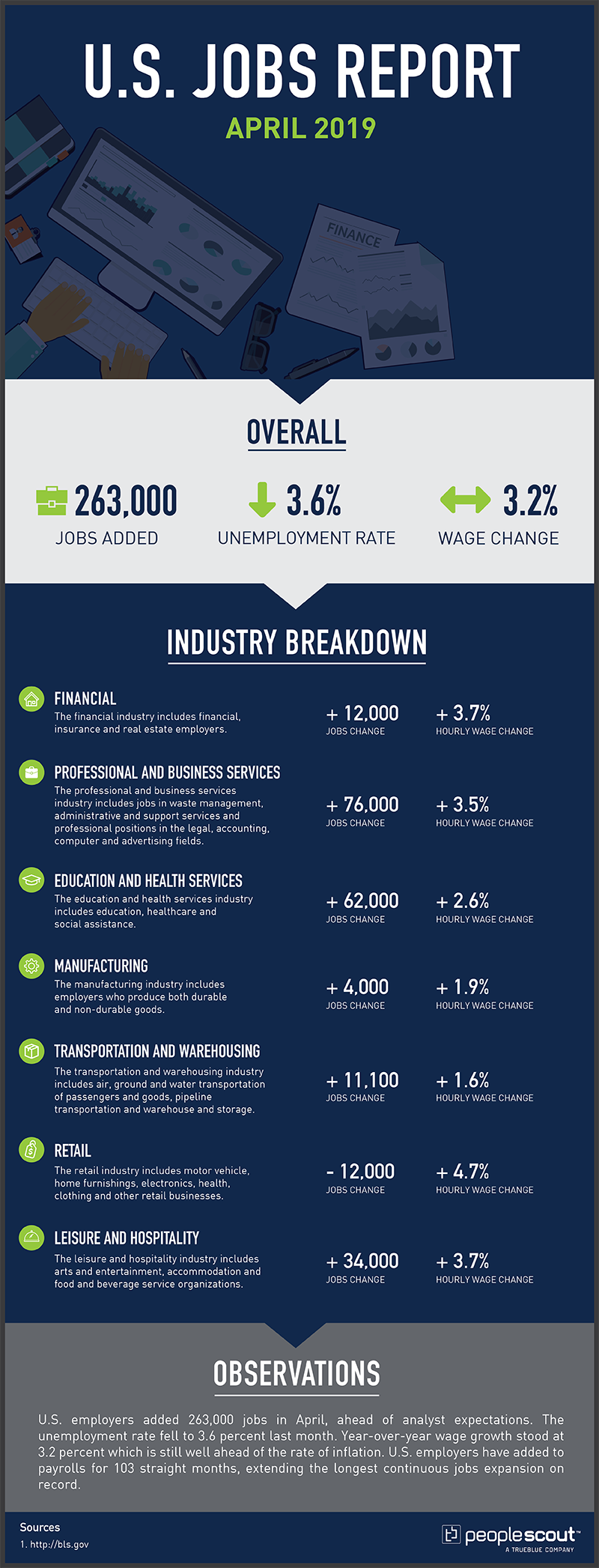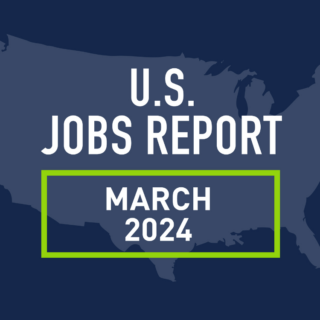The Labor Department released its April jobs report which shows that U.S. employers added 263,000 jobs in March, beating analyst expectations. The unemployment rate fell to 3.6 percent last month. Year-over-year wage growth remained at 3.2 percent, which is well ahead of the rate of inflation. U.S. employers have added to payrolls for 103 straight months, extending the longest continuous jobs expansion on record.

The Numbers
263,000: The economy added 263,000 jobs in April.
3.6%: The unemployment rate fell to 3.8%.
3.2%: Wages increased at a rate of 3.2% growth over the last year.
The Good
The U.S. economy demonstrated its resilience with the strong April Jobs report. After shedding jobs in March, manufacturing had a modest rebound adding 4,000 positions while other key economic sectors had impressive gains. Leisure and hospitality added 34,000 positions, education and health services increased by 62,000 jobs and business and professional services jobs grew by 76,000.
The jobs report was generally greeted with enthusiasm by analysts who tempered their responses with caveats about the meaning of the data as in this reporting by Bloomberg.
“It’s clearly telling you this economy is still chugging along very nicely,” Torsten Slok, chief economist at Deutsche Bank Securities, said on Bloomberg Television. “It is inflationary in the sense that wages did go up but they didn’t go up as much as we had expected. Goldilocks is the best description of this,” Slok said.
The surprising overall robustness – which didn’t reflect any surge in temporary hires for the 2020 Census, as some analysts had flagged – follows months of broad labor market strength. While the expansion is poised to become the nation’s longest on record at midyear, economists expect a deceleration this year even after a strong first quarter.
The New York Times noted that the elements of the strong job market have defied conventional economic expectations and could assuage fears of an economic downturn.
“Not that long ago, the overwhelming consensus among economists would have been that you couldn’t have a 3.6% unemployment rate without also seeing the rate of job creation slowing (where are new workers going to come from with so few out of work, after all?) and having an inflation surge (a worker shortage should mean employers bidding up wages, right?).
And yet that is what has happened, with the April employment numbers putting an exclamation point on the trend. The jobless rate receded to its lowest level in five decades. Employers also added 263,000 jobs; the job creation estimates of previous months were revised up; and average hourly earnings continued to rise at a steady rate — up 3.2 percent over the last year…
In particular, it now appears that recession fears that emerged at the end of 2018 were misguided — especially once the Fed backed off its campaign of rate increases at the start of 2019.”
The Bad
The participation rate, those who are working or want to work, decreased in April. The broadest measure of unemployment, which includes part-time workers who want to work full-time has remained virtually unchanged since February. Despite a strong job market and rising wages, some Americans are opting out of the workforce and those who want to more fully participate have not been able to do so.
The April report also showed that the robust job market has not impacted two categories of potential talent over the last year. In April, 1.4 million persons were marginally attached to the labor force, little different from a year earlier. These individuals were not in the labor force, wanted and were available for work, and had looked for a job sometime in the prior 12 months. They were not counted as unemployed because they had not searched for work in the 4 weeks preceding the survey.
Among the marginally attached, there were 454,000 discouraged workers in April, basically unchanged from a year earlier. Discouraged workers are those not currently looking for work because they believe no jobs are available for them.
The Unknown
Jobs in the retail sector decreased by 12,000 in April and by over 49,000 in the last year. The extensive closing of retail locations has come to be known as the “retail apocalypse.” The number of store closings so far in 2019 is already larger than in all of 2018 as Business Insider reports:
“The retail apocalypse is raging on with almost 6,000 store closings announced so far in 2019 — more than the entirety of last year. According to a new report from Coresight Research, U.S. retailers have announced 5,994 store closings this year, compared with 5,864 store closings in all of 2018…Coresight Research CEO Deborah Weinswig predicted that this trend would continue. “The flood of store closures will likely continue for quite some time,” she said. An April UBS report predicted that 75,000 stores would close across North America from this year to 2026. It said e-commerce would make up a quarter of total retail sales by then.”
Retail workers affected by store closings can bring employers important transferrable skills such as customer service and inventory tracking. It remains to be seen how many of these workers will stay in the broad retail sector, including e-commerce, or be attracted into other sectors which can leverage their skills and experience.


![[On-Demand] AI in Recruiting: Hype, Ethics & Best Practices](https://www.peoplescout.com/wp-content/uploads/2024/03/ai-webinar-1-320x320.jpg)
